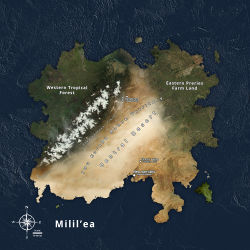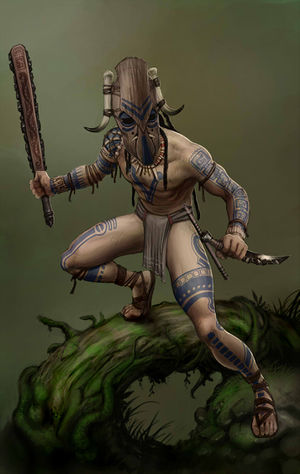- "We don't have to win. We only have to fight."
- ―Mace Windu
K'awiil is a Jedi serving the Jedi Enclave on New Tython. Unlike many who fill its ranks, he was born and raised on the planet, the son of one of the first families to settle on Milil'ea. Having been kidnapped and raised by a Harakoan city-state rather than colonials, he is one of the most outspoken members of the Jedi leadership concerning both Harakoan rights and sovereignty. Although K'awiil regards himself as a diplomat and cultural ambassador, his (at times) incendiary remarks against Tythonian colonists and modernization mean that he is typically assigned martial tasks, well away from any colonists. He currently resides part-time at the Ooroo Abbey and during the rest of the year at his residence in Wamaw.
Early History (0 ABY - 4 ABY)
Origins
 Milil'ea, showing the location of Wamaw and its empire
Milil'ea, showing the location of Wamaw and its empire
K'awiil "Ji" Labzah was one of the first children born on New Tython. His parents, refugees from Alderaan, had arrived while his mother was pregnant (and at the invitation of the Gand Jedi Ji, who was still fighting against the Empire with the Rebel Alliance at the time--it was for this Jedi that K'awiil was originally named), and they built a homestead in the Menat Basin of Owyhyee. With the arrival of an ever-increasing number of colonists and the thinning of resources, K'awiil's family elected to re-settle in the remote, but extremely lush and resource rich, western jungles of Milil'ea, his family founded a small township neighboring the Harakoan city of Tzamalenque, north of Wamaw. At its height the town, which was not long enough in existence to receive a name, was populated by twenty families of colonists (~80 individuals). The various homesteads were scattered across a large tract of land along a river bank, thought to contain precious metals. However, upon their initial settlement, the colonists were unaware of the wide river's actual depth, which, coupled with its distant connection to the ocean, allowed several freshwater variants of species of monstrous, predatory fish and eel, common in the oceans of New Tython, to make their home in the muddy depths.
Abduction
Many of the colonists arriving on Milil'ea had become accustomed to interactions with the Harakoans of the Menat and Ombo basins, who were often more interested in peaceful trading relationships than bickering over land. However, the Harakoans of Western Milil'ea, much to the surprise of the newly arrived Tythonians, reacted almost exclusively with hostility toward the would be settlers. The resolute lack of trading taking place with the local indigenous population meant that the homesteaders had an extremely difficult time surviving in jungle and within a year nearly a third of the colony had died of disease or succumbed to predatory plant and animal life. The mumanka in particular had grown a particular fondness for heaving their enormous bodies out of the water and grabbing drinking or washing colonists from the shallower parts of the river before pulling them back into the river to be eaten. By the time the war parties from Wamaw arrived in the area to hunt down and crush the remaining colonists, only fifteen individuals remained. Being deemed unfit for sacrifice, the adults were executed and left, while the children were taken back to Wamaw to be raised as Harakoans (two of whom died of disease within the first year, leaving K'awiil the only survivor of the Milil'ea jungle colony).
Iwu Wamaw (4 ABY - 23 ABY)
Tutelage
 The city-state of Wamaw, K'awiil's home
The city-state of Wamaw, K'awiil's home
Being abducted at such an early age, K'awiil acclimated quickly to life in a Harakoan polity, and, despite his inability to replicate many of the crest-vowels which lend Harakose its fluty, musical tones, became relatively proficient in the language for a non-Harakoan. Stripped of any technological advantage or sense of moral superiority, the young human was an intriguing specimen to the Harakoan elite of Wamaw, who had hoped to glean whatever information they could about the tenacity of potential invaders from across the seas. In reality, their efforts proved fruitless and the novelty of K'awiil had worn off by the end of the year. Having no family, he was given the surname "Labzah," which meant "rotting" in the local Harakose dialects, and, though he was not abused, was relegated to performing whatever simple, household tasks could be expected of a six year old. However, the priestly caste's interest in the boy was rekindled when he began to display an aptitude for moving about the palace unseen and moving objects, seemingly with his mind. The priests were quick to bring him into the house of Emperor Balakal II, as a companion for his only child and heir, Balakal III. Educated by the finest priests, alongside the future emperor, the young human aged and his both skill with and control over the Force grew substantially. By his sixteenth year, he was ready to enter warrior caste, alongside his boyhood companion, and was heralded as a potentially great warrior and future general.
In Service to the Warrior Caste
 K'awiil "Ji" Labzah shortly after the suppression of Tzamalenque
K'awiil "Ji" Labzah shortly after the suppression of Tzamalenque
Excelling with both his Force powers and the martial weapons of his people (particularly the macuahuitl, atlatl, and bow), K'awiil Labzah quickly became a warrior of renown, despite the handicap of his humanity. He participated in several raids against and the eventual subjugation of the neighboring city-state of Pah. Though his performance in the initial raids was lackluster, as he grew accustomed to combat, and the campaign drew out into years, K'awiil became accustomed to bush fighting alongside his Harakoan brethren. By the time the jungles surrounding Pah had been largely depopulated, K'awiil was no longer considered a green warrior, and was one of the first to lead the charge over the city-state's crumbling walls. In no small part due to his innate desire to prove himself an equal among the Wamawese warriors, the young human fought with a ferocity that saw an abnormally high percentage of the city taken captive and returned to Wamaw for sacrifice. Additionally, rumors among the social elite of Wamaw, claim that K'awiil intentionally started fires within the city walls, which resulted in enough destruction that the formerly impressive city is still recovering. However, the rewards bestowed upon him by Balakal II gave K'awiil the financial means to found his own household in Wamaw, elevating him to the nobility, and resulting in him being given command, as a Nacom, of one of the city's large war parties.
With its chief rival in the region subdued, Wamaw began to exert its authority over its fledgling empire, and Pah, in no state to resist, became subject to heavy taxes and frequent raids for captives. Tzamalenque, however, had become subject to Wamaw through a diplomatic union, and retained its full military and economic strength. Fearing that it, too, would become the victim of Wamawese oppression, the city rose in rebellion under King Chakam Bal VII, the second cousin of the Wamawese emperor in 20 ABY. Emperor Balakal II dispatched his multitudes of warriors under the senior leadership of his son, who marched the warriors swiftly north through the jungle, toward Tzamalenque. The two armies met on the plains overlooking the city and, although Chakam Bal's warriors inflicted enormous casualties on the forces of Wamaw, the superior numbers and equipment of Balakal III's army led to a decisive rout of the Tzamalenque forces and the encirclement of the city. K'awiil Labzah, due to the prestige of his position and his unit, had been held in reserve for most of the battle and, thus, with the most intact war band, spearheaded the attack through the city's gates. Despite ripping the wooden gates aside with the Force, K'awiil was wounded early in the assault, the human remained alongside his warriors as they surged through the entrance to the city, pushing the defenders back through the streets to the palace, where they remained as K'awiil's warband began to loot the area. Although the eventual assault on the palace proved deadly for many of the Harakoan warriors, Chakam Bal VII was captured and sent back to emperor Balakal III as the human's contingent of warriors began the project of tearing down Tzamalenque's walls and earthen ramparts to prevent future rebellions. The physical destruction wrought by K'awiil on both Pah and Tzamalenque earned him, not only the hatred of Wamaw's client cities, but also the moniker "K'awiil Who Rotted Cities", a play on the originally derisive nickname bestowed upon him by the priests and nobles during his youth.
His special abilities, proven aptitude for command, and political connection to Balakal III made K'awiil a favorite contender to become a Yucnacomal (captain of the emperor's bodyguard) when Balakal II died of old age early in 21 ABY. However, Balakal III, having been courted by the ever-growing number of Harakoan-sympathetic Jedi living in the newly established city of Menat Ombo, dispatched K'awiil as his special emissary, both to ensure no more colonists would arrive on the western shores of Milil'ea and to receive training in the Jedi arts.
Acolyte of Odan-Urr (23 ABY - present)
New Tython
Encounters with the Dark Jedi Brotherhood
Outbreak of Hostilities
Characteristics

Appearance
Personality